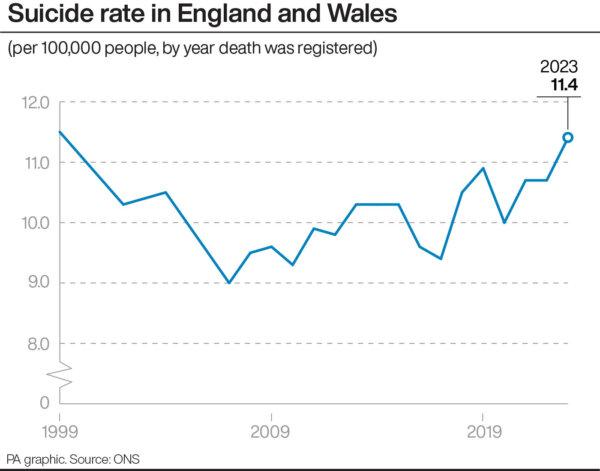The number of suicides registered in England and Wales is at its highest rate in two decades, figures from the Office for National Statistics (ONS) show.
Around three quarters of suicides were among men, which the ONS said has been the case since the mid 1990s. That rate has increased from 16.4 in 2022 to 17.4 in 2023 and is the highest rate since 1999, when it was at 18.2.
While the rate for women was lower, it was at its highest last year (5.7) since 1994 (also 5.7).
Age-specific suicide rates had increased across all groups compared to 2022, but were highest for men aged 45 to 49 (25.5) and for women aged 50 to 54 (9.2).
There was also a noted geographical difference in deaths by suicides, with London having the lowest rate of any region, at 7.3, but with the northwest having more than double that rate at 14.7 deaths per 100,000 people.
‘Worse Than Expected’
The charity Samaritans said the figures were “shocking” and “even worse than expected.”Jacqui Morrissey, assistant director of influencing at Samaritans, said: “With suicide rates at their highest in over 20 years, this should be treated as a public health crisis.
“In particular, local areas must not be left scrabbling around for the funding they need to save lives, with a deadly north-south divide now opening up as rates in the North West hit twice that of London,” she added, calling on the government to use the Autumn Budget to commit to proper investment in suicide prevention.
Responding to the figures, a Department for Health and Social Care (DHSC) spokesperson said: “Every suicide is a tragedy and these figures show a clearly worrying trend, which this government is committed to reversing.
“We know that people with mental health issues are not getting the support or care they need. That’s why we will fix our broken health system to ensure that we give mental health the attention and focus it deserves.
Men Facing ‘Silent Health Crisis’
The figures come after the Local Government Association (LGA) called for the creation of a national men’s health strategy in England to tackle a range of gender-specific health concerns, including high suicide rates.David Fothergill, chairman of the LGA’s community wellbeing board, said last week, “Men in England are facing a silent health crisis, dying nearly four years earlier than women with high rates of cancers, heart disease, type 2 diabetes, and suicides.”

Fothergill said local council programmes aimed at tackling other health concerns faced by men were making progress, but that there needed to be a national effort for men, similar to the 10-year health strategy launched by the government for women in 2022, which aims to improve how the health care system interacts with women and girls.
“We are calling for men’s health to be recognised as a national concern, and for the government to implement a men’s health strategy,” Fothergill said.
He added, “Innovative local initiatives led by councils are making strides, but national action is needed to help close the life expectancy gap.”
A DHSC spokesperson said the government’s 10 Year Plan for Health “will outline how we will ensure men are able to access the support and targeted interventions they need.”
“Our plans to reduce obesity, improve cancer survival rates, and enhance mental health services will also help to tackle the main drivers of poor health in men,” the spokesperson said.







